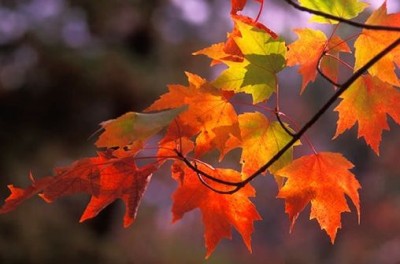Metamorphosis of colors from bright yellows to vibrant reds during fall
 I have always been fascinated by the magical splendor of colors that the leaves display at the start of the fall in US during September-October. The changing matrix of colors of fall foliage never fails to surprise and delight me. Why does a fall leaf changes color? Where do the yellows, reds, purples and oranges come from? These questions pop up every time I watch this game of chiaroscuro played with clock-work precision year after year by the “Autumn Leaves”!
I have always been fascinated by the magical splendor of colors that the leaves display at the start of the fall in US during September-October. The changing matrix of colors of fall foliage never fails to surprise and delight me. Why does a fall leaf changes color? Where do the yellows, reds, purples and oranges come from? These questions pop up every time I watch this game of chiaroscuro played with clock-work precision year after year by the “Autumn Leaves”!
Curbing the tendency to dwell deep into a long-winded botanical explanation of the phenomenon, let me try to put it in everyman’s language.
Why and how leaves change color during autumn?
Leaves are plants’ food factories endowed by nature. They manufacture most of the foods necessary for the tree’s growth. Plants take water from the ground through their roots and carbon dioxide (CO2) from the air and use sunlight to turn water and carbon dioxide into oxygen and glucose.
This food-making process is called photosynthesis. That means “putting together with light”. A chemical called “Chlorophyll” present in the numerous cells of the leaf helps make photosynthesis happen. Chlorophyll is what gives leaves their green color.
The leaves contain many color pigments in addition to the green pigment, viz: yellow, orange, red etc. But most of the year these colors are masked by great amounts of green coloring during spring and summer.
But in the fall (autumn), length of daylight gets shorter and temperature also falls considerably. To match with this change, the leaves understand their passive role and their chlorophyll breaks down. Consequently the green color disappears, bringing forth the hitherto dormant color range of yellow to orange which give the leaves part of their fall splendor.
A few other chemical changes may also occur, which cause additional colors like red and spectrum of reddish and purplish fall colors of trees such as dogwoods and sumac, while others give the sugar maple its brilliant orange.
The autumn foliage of some trees show only yellow colors. Others, like many oaks, display mostly browns. All these colors are due to the mixing of varying amounts of the chlorophyll residue and other pigments in the leaf during the fall.
In addition to this metamorphosis of colors, the bonding between the stem of the leaf and the tree get severed and the leaf is finally blown off by the wind or it falls from its own weight. This completes the “fall”.
Crowds of autumn tourists flock every year to the flame-colored hills of north-eastern US, to view the fall foliage aka autumn leaves. There is a booming tourism industry in those parts.
And this is the story of the rich and vibrant hues of the fall foliage!.
Come winter, and the trees start hibernating! (But is there any other reason for the leaves falling off the trees? May be there is. Wait for my next article!)
Wanna know more about the Splendor of Autumn? Visit this highly informative and illustrated web page of SUNY College of Environmental Science and Forestry.
You made some decent points there. I did a search on the subject and found most people will agree with your site.
Howdy this is kinda of off topic but I was wondering if blogs use WYSIWYG editors or if you have to manually code with HTML. I’m starting a blog soon but have no coding know-how so I wanted to get guidance from someone with experience. Any help would be enormously appreciated!
Nice post. I learn something more challenging on different blogs everyday. It will always be stimulating to read content from other writers and practice a little something from their store. I’d prefer to use some with the content on my blog whether you don’t mind. Natually I’ll give you a link on your web blog. Thanks for sharing.